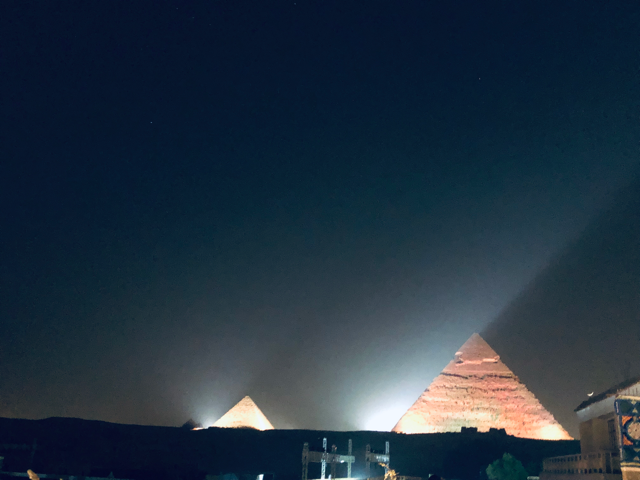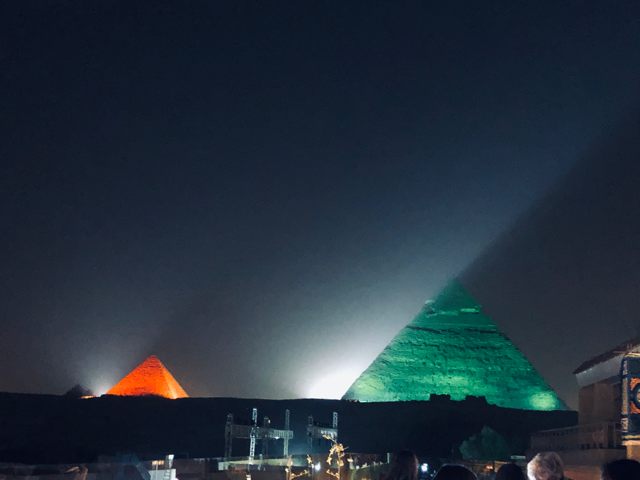Egypt: The Great Pyramids and Memphis
- Susan Donnelly
- Dec 5, 2020
- 7 min read

In the morning, we woke up at our campsite in the otherworldly landscape of the Western Desert with hardly anyone else in sight:

That evening we were drinking a glass of wine on our hotel balcony overlooking the pyramids in a metropolitan area of over twenty million people.
In typical photographs, the pyramids appear massive and aloof on the desert sands, remote from modern civilization. We took such a photo the next day ourselves.

However, this is what might be called the backstage side of the pyramids. The reality on the other side was quite different. Dozens of buses were unloading tourists inadequately protected from the blistering sun, many of them turning beet red as they clambered up the lower levels of the pyramids to pose for photos. The local village presses up against the restraining walls only a few hundred feet away. You can even play golf at a nearby resort. We were rather surprised and a bit disillusioned by the scene.
However, our guide, Achmed, insisted on getting us in a few classic tourist shots of our own. What can you do?
Our hotel had arranged for Achmed and a driver to show us the sights on our one day in the Cairo area. Here we are with Achmed in the backstage area.

And, of course, there was the great Sphinx.
And, of course, here is our touristy shot with the great Sphinx.

We were not interested in going into the city itself (way too many people) so after visiting the pyramids and the sphinx, our guide took us to the government sponsored Papyrus Institute where artisans make genuine papyri from the reeds. We were greeted at the door by a bald guy who gave us a step by step demonstration.

First, he showed us a papyrus stalk, which he skinned to reveal the white pith inside.

Next, the pith is flattened by hammering and rolling it.

Then it is soaked in water to remove the sugar content.

Finally, the strips are pressed together into a mat.

With a finished piece of papyrus, he showed us how it can be crumpled, folded, or soaked in water without causing any damage.

The shop displayed a huge collection of gorgeous, luminous paintings done on the papyri by local artists. Some depicted scenes from ancient tombs or temples. We were hooked! We brought home three:
a representation of the zodiac;

a scene depicting the weighing of a person’s heart at their judgement day;

and a painting of Nut, goddess of the sky who swallows the sun each evening and gives birth to it again each morning.

We now have these framed and hanging in what I refer to as our celestial room.
Next, Achmed took us to a place where they make perfumes and essential oils. We were first treated to a demonstration of glass blowing. All the colorful and delicate perfume bottles are made by hand.
The proprietor then invited us to sit for a smell testing session of some of their wares which was rather fun. We ended up purchasing a few samples to bring home and they gave us a delicate little diffuser as well. Amazingly, it made it home in one piece. However, one bottle of a floral essence broke in my husband’s duffel bag and gave everything a lovely aroma.
For the afternoon, Achmed suggested we take a drive to see the remains of the ancient city of Memphis, one of the first capitals of Egypt. On the way, we stopped for lunch at a large tourist-ready restaurant. Even though it was obviously a regular stop for tour buses, it turned out to be quite good, At the entrance was a woman making fresh puffy pita bread in a wood-fired oven. David was, of course, intrigued and took a short video.
The restaurant served a standard menu for everyone featuring grilled chicken and ground beef kebabs (keftas) served on a hibachi type grill at the table. There were also dips and salad and lots of fresh, hot pita bread,
Although it was a very hot day, the restaurant felt cool and airy. The woven domed ceiling probably helped to create a natural type of air conditioning system.


As we were making our way back to the car, I started to notice strange things beside the walkway -- a family of armless mannequins, the woman sitting beside a fake pita oven.

Next, a bald albino mannequin was propped in the crook of a tree as if it was a child playing.
Then I noticed the Alice in Wonderland toadstools missing a cap, and the carousel horse with a broken leg in the decrepit playground, and the old heap of a vehicle in the bushes.
And, looking over the scene from the balcony, a woman and boy mannequins.

I was glad I had not noticed all of this on the way in -- the macabre scene would have creeped me out and ruined my appetite. Was it the product of a really strange imagination with a weird sense of humor -- maybe a Monty Python fan? Or maybe a spoof on a Disneyland-type of tourist attraction? Or perhaps it was a sophisticated artistic statement about a place where people come from all over the world to see mummified artifacts of the past? Or, was it all accidental and just a result of neglect and vandalism? Hard to know. But it was kind of strange to go from there to see the Colossus of Ramses II lying down with broken legs.

Even with broken legs, it is a remarkable statue, about 30 feet tall with elegantly carved features.

Outside, there was a sadly damaged sphinx and a carved sarcophagus.
There was also a standing statue of Ramses II being guarded by a lazy dog.

Next, we drove to the Saqqara Necropolis Complex, the burial grounds near Memphis where there are some of the earliest pyramids ever built. First, we visited the tomb of Kegemni, Chief Justice and Vizier to King Teti (ca. 2300BCE), which consists of several chambers with detailed scenes of daily activities chiseled in raised relief. There were scenes of people fishing, of a hippopotamus hunt, and of crops complete with insects and a frog.
On the Osirisnet website, the author gives us some advice on how to appreciate the carvings -- how to imagine them as creating a virtual world for the dead visier to live on in the afterworld.
“In the Old Kingdom it was not the custom to represent divine scenes nor even ones of a God, as can be seen in later times.
The themes which Kagemni chose are stereotypical of the time, relating entirely to his terrestrial activities and his cult, intended to show the abundance of goods which he enjoyed, the fertility of his livestock, the wealth of his fields… This is why the agricultural scenes of hunting and fishing, as well as those of transportation of various riches constitute the main part of the tomb's artistic itinerary.
By chance, the very precise layout of the scenes enables us to apprehend many details. Sometimes they are scientific details, like the techniques of hunting and fishing, or the identification of species of birds or fish. Elsewhere they are details of movement, like the small calf which a herdsman carries on his back whilst crossing the water, and which turns its head as if to call its mother. Some very lively festive scenes are also found.
The outdoor scenes occupy the first rooms, whilst the scenes relating to the funeral meal are concentrated in the most remote part of the tomb. The inscriptions contain the title of the scenes, the description of the offerings and their source, as well as the titles of Kagemni.
They are visually punctuated by the conversations or interjections exchanged by the master's servants. So it is necessary to imagine the chapel as being magically alive, busy with the activities of daily life, in which Kagemni participates as if he were alive. It is important to know how to hear, in the silence of the rooms, the men who challenge and respond to each other, it is necessary to "see" them not as figures in the stone, but really DOING what is represented. A whole world is then opened to our eyes.”
A centerpiece of the Saqqari necropolis is the Pyramid of Djoser, or Step Pyramid, and the complex of buildings surrounding it, we approached it through a roofed colonnade that was impressive itself, as you can tell from our expressions,

The four-sided pyramid is composed of six steps and was most likely engineered by Imhotep, the ancient genius of architecture and medicine who was Djoser’s chief minister.

We marvelled that this structure of massive hewn stones was built over 4,000 years ago.
In other parts of Egypt, we had seen areas where there was quite a bit of trash along the roadways but nothing like what we saw between Memphis and Giza and a lot of it was along the banks of a canal. Apparently this is a problem they have been struggling with for a number of years and it appears there is still no solution in sight.
Back at our hotel, the receptionist told us there was a nightly pyramid light show that we could view from the rooftop cafe so we washed off the desert dust and headed up there for dinner. The light show turned out to be worthy of a Disney production. Booming voices came from the sphinx and the three pyramids telling of the gods and the pharaohs. We could only understand snippets of what was said though. To get the full effect, you have to purchase tickets to sit in the amphitheater below. However, from our perch, we had a great view of the pyramids with changing colored lights. With the special effects on my iPhone, I was able to enhance the show even more. Check out the slideshow below by clicking on the arrow on the right side of the photo.
Once the show was finished, everything was dark and quiet for about fifteen minutes. Then, we were surprised when the lights came back on and the sphinx started booming out his story once again, this time, though, it was in Chinese. A little odd, but no more weird than it speaking in English I guess.
After that rather fantastical ending to our many-faceted time in Egypt, we boarded a plane the next day for Greece, our last stop on our round-the-world trip.































































































Comments